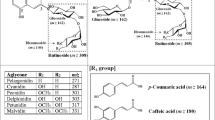Summary
The anthocyanins of 43 varieties and 4 wild forms of Iris ensata in their outer perianths were analysed by high-performance liquid chromatography procedures. Using the different components of major anthocyanins, each variety and wild form were classified into six types such as malvidin 3RGac5G-petunidin 3RGac5G, petunidin 3RGac5G-malvidin 3RGac5G, malvidin 3RGac5G, petunidin 3RGac5G, delphinidin 3RGac5G and malvidin 3RG5G-petunidin 3RG5G. Among these types, the delphinidin 3RGac5G type was noteworthy because such a type was useful for the breeding of a blue flower. The malvidin 3RGac5G-petunidin 3RGac5G type accounted for ca. 70% of the varieties and all wild forms examined. This type, therefore, was regarded as the basic one for I. ensata, while the other types were variants for major anthocyanins. There was no particular relationship between flower colors such as purple, red-purple, blue-purple, light-purple and pink and the types of major anthocyanins except for one, i.e. all varieties classified into the malvidin 3RGac5G or petunidin 3RGac5G type exhibited pink flowers. Finally, the utility of the relative species for the breeding of new flower varieties of I. ensata was discussed.
Similar content being viewed by others
References
Asen, S., R.N. Stewart, K.H. Norris & D.R. Massie, 1970. A stable blue non-metallic co-pigment complex of delphanin and C-glycosylflavones in Prof. Blaauw Iris. Phytochem 9: 619–627.
Brouillard, R., 1988. Flavonoids and flower color. In: J.B. Harborne (Ed.), The flavonoids. pp. 525–538. Chapman and Hall.
Hayashi, K., 1940. Isolation of ensatin, an acylated anthocyanin from the flowers of Japanese iris. Proc. Imp. Acad. Tokyo 16: 478–481.
Hayashi, K., S. Ootani, K. Sato, T. Tuyama & N. Ishikura, 1978. Chemotaxonomical studies on Japanese irises in relation to the flavonoids in flowers. Res. Inst. Evolut. Biol. Sci. Rep. 1: 1–16 (in Japanese with English summary).
Ishikura, N. & E. Yamamoto, 1978. Anthocyanins in the flowers of Japanese garden iris belonging to ‘Higo’ line. Kumamoto J. Sci. Biol. 14: 9–15.
Lawrence, G.H.M. & L.F. Randolph, 1959. The classification of irises. In: L.F. Randolph (Ed.), Garden irises. pp. 133–160. The Cayuga Press.
Saito, N., 1989. Seishokuka-no-Shikiso-to-Kashoku-no-Anteika. Bio. Horti. 2: 49–59 (in Japanese).
Samata, Y., 1971. Kashoku-no-Shinka-to-Toen-Kozatsu. Ikushugaku-Saikin-no-Shinpo 12: 49–64 (in Japanese).
Takeda, K., 1980. Antoshinanin-niyoru-Kashoku-no-Hatsugen. In: K. Hayashi (Ed.), Plant Pigments, pp. 284–299. Yokendo (in Japanese).
Yabuya, T., K. Ushijima & T. Adachi, 1986. HPLC analysis of anthocyanins in series Laevigatae species of Iris. Japan. J. Breed. 36 (Suppl 2): 90–91 (in Japanese).
Yabuya, T., 1987. High-performance liquid chromatographic analysis of anthocyanins in induced amphidiploids of Iris laevigata Fisch. × 1. ensata Thunb. Euphytica 36: 381–387.
Author information
Authors and Affiliations
Rights and permissions
About this article
Cite this article
Yabuya, T. High-performance liquid chromatographic analysis of anthocyanins in Japanese garden iris and its wild forms. Euphytica 52, 215–219 (1991). https://doi.org/10.1007/BF00029398
Received:
Accepted:
Issue Date:
DOI: https://doi.org/10.1007/BF00029398




